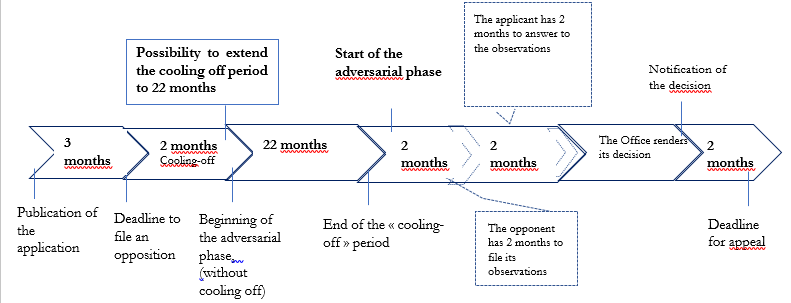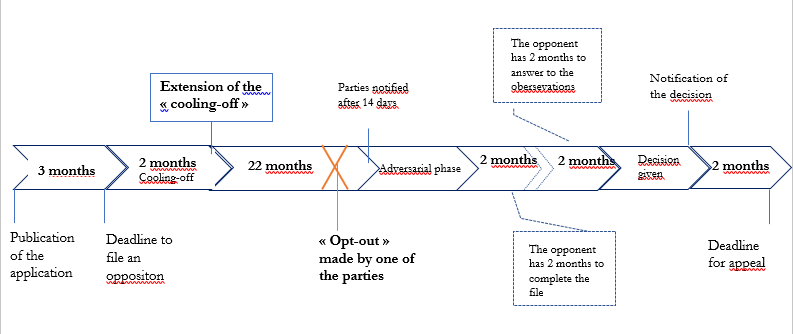Before going in depth into the opposition proceeding, it is necessary to understand the difference between a formal opposition and a substantive opposition. A formal opposition is an opposition in which the application will only present elements that identify the parties all other documents related to the trademarks. The applicant must file a formal opposition within three months from the publication of the application trademark. On the contrary, a substantive opposition is an opposition in which the applicant will put his/her arguments and explanation on why he/she wants to oppose to the trademark.
How does an opposition application to the EUIPO work?
When a European Union trademark is filed before the EUIPO, and approved, the EUIPO publishes the European Union trademark application. After the publication, owners of earlier trademarks can file an opposition to the registration of the trademark. They have three (3) months to file an opposition, starting from the publication date. It is important to bear in mind that this period cannot be extended.
This opposition may result in a total or partial rejection of the trademark application or in the rejection of the opposition. However, before proceeding with a trademark opposition application, it is advisable to first contact the applicant in order to find an amicable solution. It is also advisable to consult a specialist in trademark law or a lawyer specialising in intellectual property law.
An opposition application before the EUIPO can be filed against a European Union trademark application or an international trademark designating the European Union.
This is custom heading element
According to Article 8 of the European Union Trademark Regulation, an opposition can be filed on six grounds:
- An earlier identical or similar mark registered for identical or similar goods or services
- Trademarks which, at the date of the application for registration of the European Union trademark or, where applicable, of the priority claimed in respect of the application for registration of the European Union trademark, are well known in a Member State, in the sense in which the words “well known” are used in Article 6bis of the Paris Convention
- Trademarks registered under international arrangements having effect in a Member State
- An application for a designation of origin or geographical indication filed, in accordance with Union or national law, before the date of the application for registration of the European Union trademark or the date of the priority claimed for the application, subject to its subsequent registration, and which confers the right to prohibit the use of a subsequent trademark
- An unregistered trademark or other sign used in the course of trade which does not have a mere local significance
- When an application for a European Union trademark has been filed by the agent or representative of a trademark owner without his consent
It should be noted that it is possible for the opponent to rely on an unregistered trademark or other sign used in the course of trade which does not have a mere local significance. Indeed, the contested trademark will not be registered if and to the extent that the rights in that sign were acquired before the date of the application for registration of the European Union trademark or the date of the priority claimed for the application for registration of the European Union trademark; or if that sign confers on its proprietor the right to prohibit the use of a later trademark.
Understanding the cooling off period
The so-called “cooling off” period provides a period of reflection during the two months following the notification of the opposition and before the start of the adversarial phase. This period can be extended for a maximum of 22 months, i.e. a total of 24 months.
This period is particularly interesting as it allows the parties to negotiate an amicable agreement and, if such an agreement is reached, the opposition procedure will be closed.
In addition, it is also possible for either party to terminate the cooling-off period (“opt-out”) by written notification, without obtaining the agreement of the other party. If one of the parties takes the initiative to end the cooling-off period before it expires, the Office will notify both parties of this decision and set the end of the cooling-off period at two weeks.
In this case, the adversarial phase of the procedure will commence the following day. In the same notification, the Office will indicate the new deadlines for completing the opposition file and the applicant’s reply, which are 2 and 4 months respectively from the end of the reflection period.
A detailed overview of the opposition procedure before the EUIPO
- Hypothesis without opt-out

2. Hypothesis with opt out

Dreyfus & associés is at your disposal for any questions concerning the opposition procedure before the EUIPO. We are ready to accompany you throughout the procedure in order to ensure the defence of your rights. Given the technical nature of the matter, it is essential to consult a specialist in trademark law or an attorney specialised in intellectual property law.
